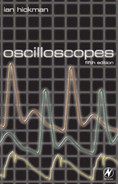
248 Oscilloscopes
Writng Gun, j
J
/- ,'
High Frequency Deflector
Rxding
Gun
(a)
'~o
m- ~'lq gUWm~TI[
(b)
Figure 11.18 (a) The scan converter tube used in the SCD 1000. (b) The diode
matrix storage target used in the SCD 1000's scan converter tube. The SCD 1000 is
discontinued, but many are still in use (courtesy Tektronix UK Ltd)
low-speed reading beam from top to bottom, left to right by the
reading gun, which operates as a high-speed video camera. But
the system involves no phosphor, no conversion of the stored
trace to light and then back to an electrical signal with the
attendant losses found in early scan conversion systems. Whilst
the scan rate of the writing beam in the X direction is constant,
the charge deposited on the storage diodes at any point will be
inversely proportional to the speed of spot movement, which is
obviously much greater when there are high-frequency signal

How oscilloscopes work (3): storage c.r.t.s 249
components of high amplitude present. Thus the density of
charge deposited at different points of the trace is not constant,
leading to the possibility of 'blooming' (speading of the trace to
adjacent areas, a perennial problem also with direct-view storage
tubes) on the one hand, or inadequate storage of the trace on the
other. Circuits within the instrument help in controlling this
aspect of operation.
On readout, the digitized charge data is stored in an array, after
correction for an}, variations in sensitivity across the target
(stored in a reference 'background' array). It is then processed to
find the centre of the stored charge pattern at each point,
resulting in a unique vertical value associated with each
horizontal location. The resultant data is available over the GPIB,
and can be displayed if required on the optional display screen of
the instrument. The system provided an effective single shot
writing rate of up to 200Gs/second in the Tektronix SCD1000
Waveform digitizer, now discontinued (see Figure 8.21).
The LA354 analogue storage oscilloscope from LeCroy uses an
indirect image converter tube. This instrument is illustrated in
Figure 10.14.
Reference
Schmid,
J. Principles of Storage Tubes and Oscilloscopes,
third edn, Tektronix UK Ltd,
1977.
..................Content has been hidden....................
You can't read the all page of ebook, please click here login for view all page.
